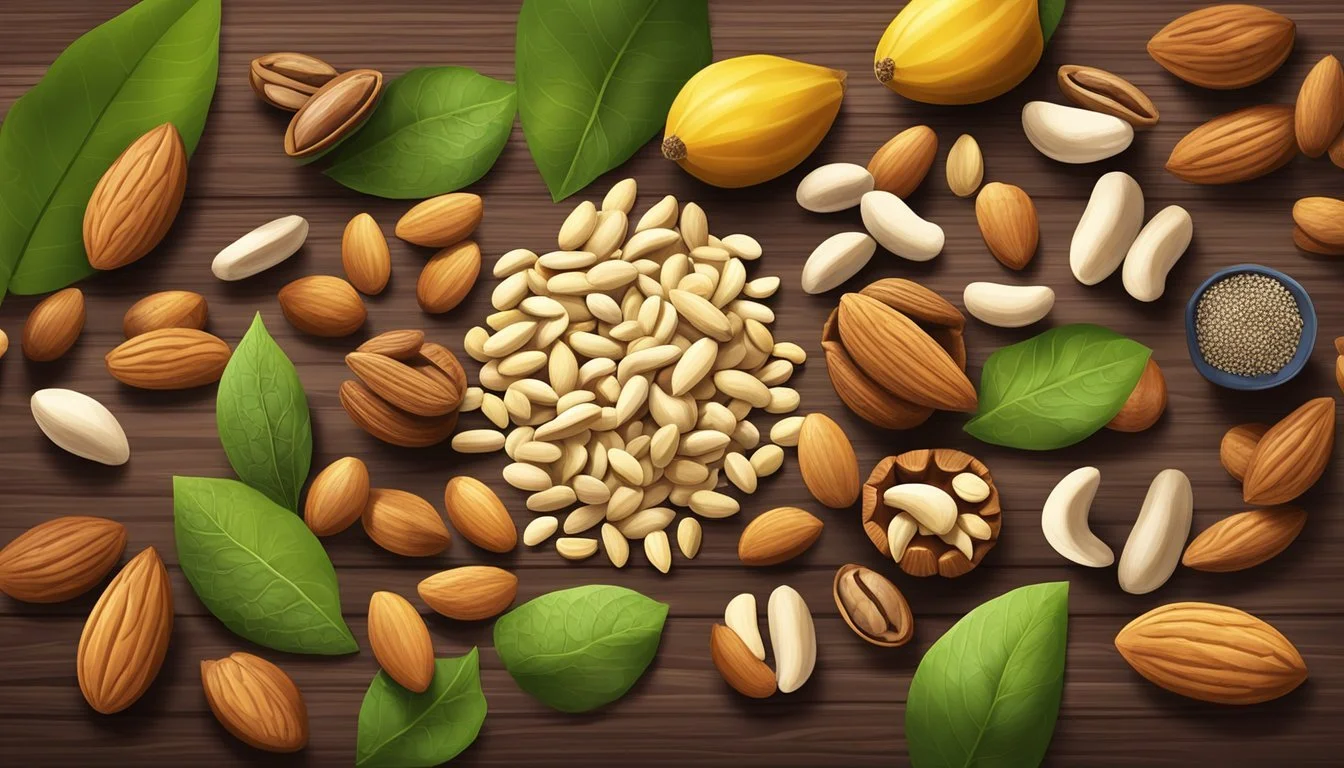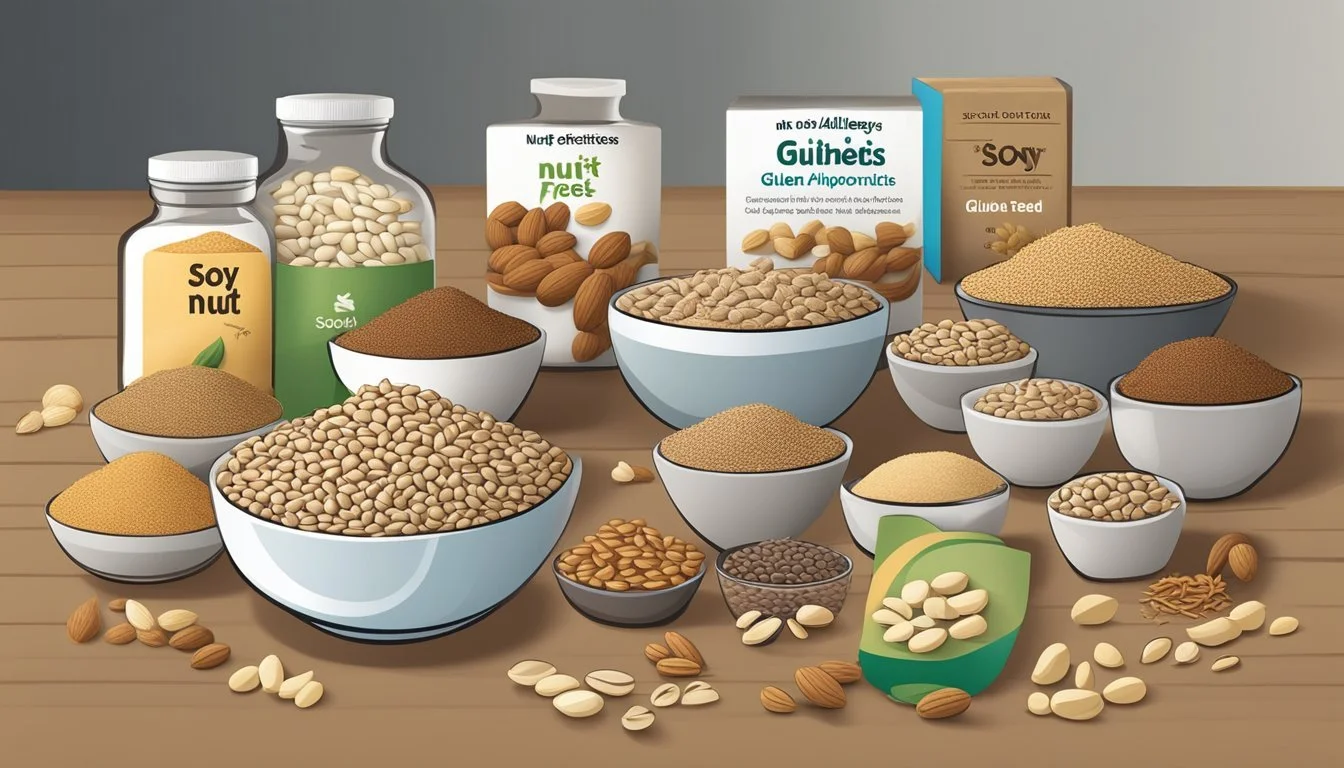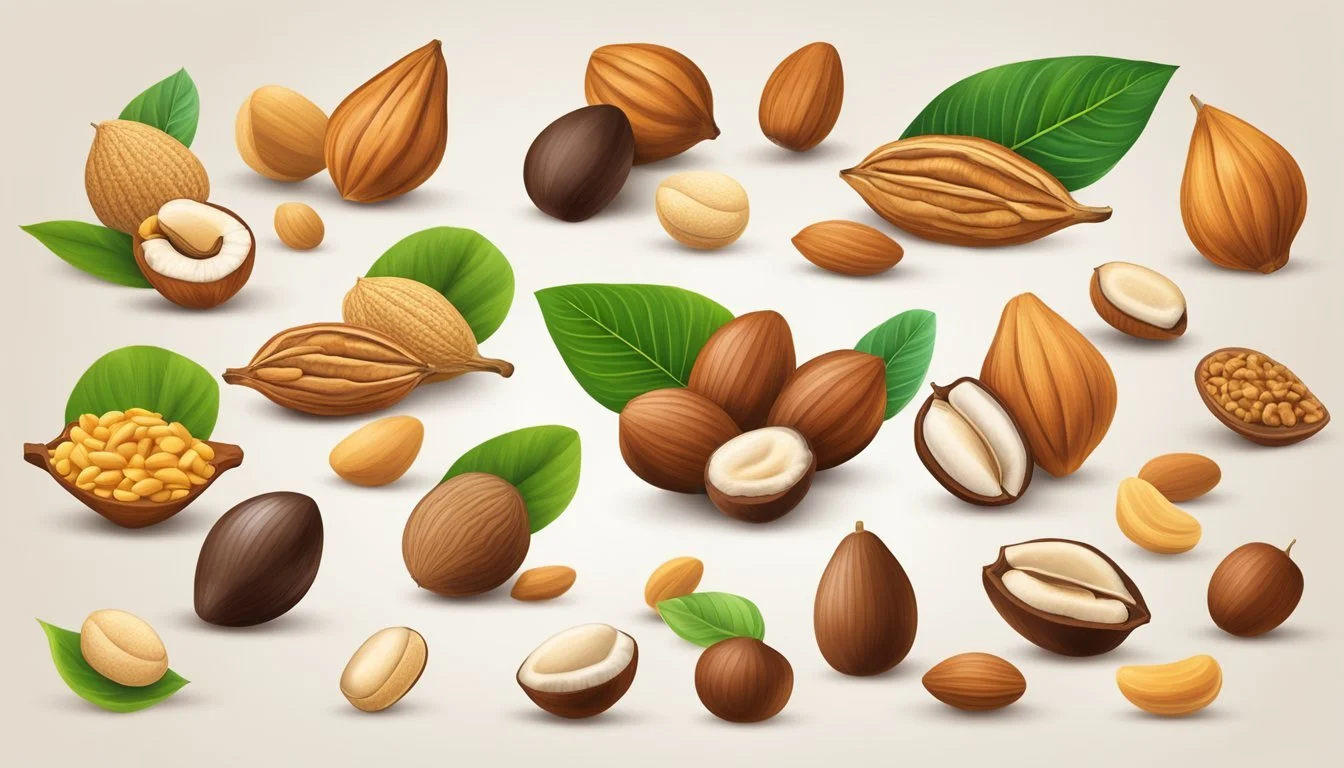Paradise Nut Substitutes
Top Alternatives for Your Recipes
Unlocking culinary secrets often involves exploring the world of spice substitutes, and for those acquainted with the exotic flavor of the paradise nut, finding an appropriate alternative is no small feat. The paradise nut, also known as sapucaya, is a lesser-known ingredient that is sometimes called for in recipes that delight in its rich, creamy texture and nutty flavor. Due to its scarcity outside of its native habitat or in non-specialty stores, cooks and chefs may need to consider substitute options that can mimic or complement its characteristics in a variety of dishes.
Understanding the integral role of this unique nut in specific culinary applications is key to selecting the right substitute. Its flavor can be a critical component of both sweet and savory dishes, imparting a distinct taste that enhances the overall palate. Potential substitutes must therefore be chosen not only for their flavor profile but also for how well they blend with other ingredients and maintain the integrity of the original recipe. With a few strategic alternatives at hand, the absence of paradise nuts can be effectively counterbalanced, ensuring that the essence of the dish remains intact.
Overview of Paradise Nut
The Paradise Nut, known for its rich historical significance and nutritional value, originates from West Africa. Rich in protein, fiber, and an array of vitamins and minerals, it serves as an integral part of the region's diet.
Historical Significance
The Paradise Nut is deeply rooted in the traditions and cuisine of West African cultures. Cultivated and consumed for generations, it has maintained its place as a local staple and holds cultural importance that extends beyond mere sustenance. Its use dates back centuries as a food source that supported the lives of many African communities.
Nutritional Profile
The nutrition provided by Paradise Nuts is quite comprehensive. Each nut contains considerable amounts of protein, which is crucial for muscle repair and growth. They are also a good source of fiber, which aids in digestion and promotes satiety. One can find essential vitamins such as vitamin E and certain B-vitamins within the nuts, which play roles in maintaining healthy skin and energy production, respectively. Furthermore, Paradise Nuts are replete with various minerals, including magnesium and zinc, vital for numerous bodily functions. Here is a brief nutritional breakdown:
Nutrient Value Protein High Fiber High Vitamins Varied (notably Vitamin E and B-vitamins) Minerals Diverse (includes magnesium and zinc)
These nuts are not only nutritious but also embody the rich, natural bounty of West Africa's flora.
Recognizing Paradise Nut Allergies
When discussing paradise nut allergies, it is important to acknowledge that they fall within the broader category of tree nut allergies, which are a significant concern for individuals with food allergies.
Common Allergens
The paradise nut, also known as Sapucaia nut, is considered a type of tree nut. Tree nuts are a common allergen and can cause serious allergic reactions in some individuals. The family of tree nuts includes, but is not limited to, almonds, walnuts, cashews, and brazil nuts. Unlike peanuts, which are legumes, tree nuts grow on trees and they share similar proteins, which can trigger allergies in susceptible individuals.
Symptoms of a tree nut allergy, which may also apply to paradise nuts, can include:
Skin reactions such as hives, itching, or eczema
Gastrointestinal symptoms like nausea, diarrhea, and abdominal pain
Respiratory problems including sneezing, nasal congestion, or difficulty breathing
Severe reactions, known as anaphylaxis, which can be life-threatening and require immediate medical attention
Nut Alternatives for Allergies
For those with paradise nut or other tree nut allergies, finding safe and suitable alternatives is crucial. Individuals should seek substitutes that provide similar nutritional value and texture without the allergenic proteins found in tree nuts.
Seed-based options have become popular substitutes because they are less likely to cause allergic reactions and often have a similar texture to nuts. Examples include:
Sesame seeds and sesame seed spread, also known as tahini
Sunflower seeds and sunflower seed butter
Pumpkin seeds and pumpkin seed butter, known as pepitas
These alternatives are not only nutritious but are also versatile and can be integrated into a variety of dishes, from spreads to baked goods. It is essential for consumers to check labels to ensure these substitutes are processed in a nut-free facility to prevent cross-contamination.
Culinary Uses of Paradise Nut
The versatility of Paradise Nuts is well regarded in culinary practices, where they're utilized for their distinct flavor in a variety of dishes ranging from traditional West African cuisine to contemporary savory and sweet applications.
Traditional West African Dishes
In West Africa, Paradise Nuts are often ground into a fine powder and used to season soups and stews, imparting a unique peppery taste with subtle hints of citrus. They are integral to creating authentic flavors in many regional dishes. The seeds are sometimes toasted to enhance their flavor before being incorporated into rice dishes.
Baking and Desserts
Bakers value the nuanced spice profile of ground Paradise Nuts, which can add depth to baked goods. When used in dessert recipes, they deliver a delicate, aromatic quality to cakes and cookies. Incorporating Paradise Nuts into oatmeal or granola can infuse these breakfast staples with a lively, peppery note.
Savory Applications
Paradise Nuts are not limited to traditional uses; they can elevate the flavor profile of various savory dishes. When added to roasted vegetables, they lend a warm, spicy kick. Chefs may also rub ground seeds onto chicken before roasting, creating a crust that is both flavorful and aromatic. Additionally, these nuts are a unique complement to grain-focused dishes, bringing a robust essence to otherwise mild grains.
Flavor Profile and Substitutes
When seeking alternatives for Grains of Paradise, understanding their distinctive flavor and determining suitable replacements are crucial for culinary applications.
Grains of Paradise Characteristics
Grains of Paradise exude a unique flavor that is warm, peppery, and slightly citrusy. The complexity of their taste also carries hints of pungent spiciness, making them a distinctive spice in various dishes.
Suitable Substitutes for Cooking
Grains of Paradise are not always readily available, but there are several other spices that can mimic their complex and vibrant profile. Here is a list of suitable substitutes along with recommended substitution ratios:
Cardamom: Often suggested for its pungent, slightly citrus-like quality. Use in a ratio of 1:1/2 to 1, meaning for every 1/2 teaspoon of Grains of Paradise, one can use a quarter to a half teaspoon of ground cardamom.
Ginger and Black Pepper Combination: This duo offers a piquant bite reminiscent of the Grains of Paradise's heat and punch.
Allspice: Known for its peppery flavor complemented by warm notes of cinnamon, nutmeg, and cloves. Substitute in equal amounts to Grains of Paradise.
Sansho Powder: Provides a zesty, citrusy taste with a unique numbing sensation. Use 1/4 to 1/2 teaspoon as a substitute for 1 teaspoon of Grains of Paradise.
Pink Peppercorns: These berries add a fruity sweetness along with a peppery bite, acting as another viable alternative.
Each of these substitutes can bring a similar depth and complexity to dishes that would typically benefit from the inclusion of Grains of Paradise.
Grains of Paradise in Other Industries
Grains of Paradise, a spice rich in history, have found their way into various sectors beyond culinary uses. They are particularly noted for their impact in brewing, distilling, and the creation of fragrances.
Brewing and Distilling
In Europe, Grains of Paradise have had a significant role in the brewing and distilling industries. Craft beer brewers infuse these aromatic seeds to impart a warm, peppery flavor with subtle citrus notes. This spice is also featured in the production of gin and other alcoholic beverages, valued for its ability to enhance botanical complexity.
Craft Beer: A popular addition for its piquant taste.
Gin: Utilized for its aromatic characteristics during distillation.
Perfumery and Aromatics
Perfumery has embraced Grains of Paradise for their unique scent profile, incorporating them into fragrances to add depth and a spicy warmth. The spice's aroma, hinting at an interplay of pepper and zest, lends itself well to creating olfactory experiences that are both complex and appealing.
Smell: Employed for its pungent and refreshing fragrance.
History: Its use in aromatics dates back centuries, reflecting a storied past.
Selecting and Storing Substitutes
When choosing substitutes for paradise nuts, consumers should consider the shelf life and storage needs to maintain the substitute's integrity and flavor. Different substitutes will vary in calories and fat content, which can affect their suitability in certain diets.
Shelf Life
Substitutes for paradise nuts typically include seeds like pumpkin or sunflower and spices such as ground cardamom. Seeds generally have a shelf life ranging from 2 to 6 months when stored properly. Spices like ground cardamom, on the other hand, can last up to six months to a year.
Pumpkin/Sunflower Seeds: 2-3 months (shelf stable), 4-6 months (refrigerated)
Ground Cardamom:
Pantry: 6 months
Refrigerator: 1 year
It's important to note that the flavor of spices diminishes over time, even if the product doesn't spoil.
Storage Tips
Effective storage is key to maximizing the freshness and lifespan of paradise nut substitutes.
Seeds:
Store in a cool, dry place, away from direct sunlight.
For extended shelf life, refrigerate in an airtight container.
Ground Cardamom and other spices:
Keep in airtight containers to prevent moisture.
Prefer a dark cupboard away from heat sources to protect flavor and oils.
Storing these substitutes correctly ensures they retain their nutritional value and flavor. Calories and fat content can also be preserved best by storing items in cool, dark environments to prevent the degradation of fats into rancid off-flavors.
Health Benefits of Paradise Nut Substitutes
Substitutes for paradise nuts, such as grains of paradise, provide an array of health benefits by contributing valuable nutrients and compounds to one’s diet.
Dietary Fiber and Weight Management
Substitutes like allspice and black pepper, contain dietary fiber, which is essential for digestive health. Fiber aids in regulating bowel movements and can help in weight management by promoting a feeling of fullness, which may reduce overall calorie intake.
Substitute Fiber Content Allspice (1 tsp) 0.4 grams Black Pepper (1 tsp) 0.3 grams
Vitamins and Mineral Content
These substitutes are also a source of essential vitamins and minerals. Black pepper, for instance, contains Vitamin C and calcium, both vital for immune function and bone health respectively. Protein content in these spices, although not as high as in nuts, still contributes to the nutritional profile.
Substitute Vitamin C Calcium Protein Black Pepper (1 tsp) 0.7 mg 10.3 mg 0.3 g
By incorporating these paradise nut substitutes into the diet, individuals not only enhance the flavor of their dishes but also capitalize on their health benefits, such as promoting digestive health and supplying important nutrients.
Recipes Featuring Paradise Nut Substitutes
When incorporating substitutes for grains of paradise, cooks can maintain the unique flavor profiles in various recipes. Each subsection below offers specific alternatives to utilize in breads, meats, and vegetarian dishes (What wine goes well with vegetarian dishes?), ensuring that the essence of the original ingredient is preserved through thoughtful selection of seasonings and seeds.
Bread and Muffins
In baked goods such as bread and muffins, the numbing and citrusy flavor of grains of paradise can be replicated with Sichuan peppercorns. Ground cardamom also serves as an excellent alternative with its aromatic and citrus notes.
Gingerbread Cookies: For the warm spice and peppery note commonly achieved with grains of paradise, one can use:
1/4 teaspoon ground cardamom per 1/2 teaspoon grains of paradise
A pinch of ground allspice to add warmth and complexity without overpowering sweetness
Meat Seasonings
The unique flavors of grains of paradise enhance meat rubs, providing a depth that standard pepper cannot match. When unavailable, suitable substitutes include:
Meat Rubs: To mirror the spice's characteristic heat without compromising the flavor of the meat, use:
Ground cardamom in a 1:1 ratio for a subtle citrus undertone
A combination of ground black pepper and a hint of lemon zest for a more complex flavor profile
Vegetarian and Vegan Alternatives
Vegetarian and vegan dishes benefit from the complexity of flavors that grains of paradise impart. For these recipes, suitable substitutes are especially vital.
Hearty Vegetable Stews: Substitute grains of paradise with:
Allspice to mimic the spiciness in vegetarian broths and stews
Crushed Sichuan peppercorns for a similar mouthfeel and tingling sensation
Seed Mixtures: Pumpkin and sunflower seeds offer a nutty crunch when replacing grains of paradise in various plant-based recipes. They can be roasted to enhance their flavor.
Alternative Names and Related Species
In the world of spices, nomenclature often varies by region and culture. This section explores the various names under which Grains of Paradise is known and its related botanical family members.
Grains of Paradise and Its Aliases
Grains of Paradise, scientifically known as Aframomum melegueta, is a spice celebrated for its piquant taste with shades of citrus. It goes by several monikers:
Alligator Pepper: Due to the seed's textured surface, which resembles alligator skin.
Guinea Pepper: Reflecting the plant's origin in West Africa, specifically the Guinea region.
These aliases serve as important identifiers across different markets and culinary traditions.
Botanical Cousins
Grains of Paradise belongs to the ginger family, Zingiberaceae. This family includes a plethora of spices that share a genetic kinship with Aframomum melegueta.
Its closest relatives are:
Ginger: A ubiquitous root used across numerous cuisines.
Cardamom: Known for its intense, aromatic flavor profile.
The familial ties among these spices often allow them to be used interchangeably in a pinch, with each bringing its unique twist to a dish.
Addressing Dietary Restrictions
When substituting paradise nuts, it is important to consider dietary restrictions such as tree nut allergies and the need for gluten-free or vegan options. The following substitutes are chosen to ensure inclusivity in dietary practices.
Tree Nut Free Alternatives
Those with tree nut allergies require substitutes that don't trigger allergic reactions. Seeds serve as a safe and nutritious alternative. Here are some tree nut-free options:
Sesame Seeds: Rich in flavor and can be used whole or in the form of tahini paste.
Pumpkin Seeds (Pepitas): They offer a crunchy texture and are suitable for both sweet and savory dishes.
Sunflower Seeds: A versatile choice that can be incorporated into various recipes.
Chia Seeds: Excellent for adding to baked goods for a nutty flavor without the allergenic risks.
For a more exotic choice:
Coconut: Shredded coconut or coconut flakes can mimic the texture and richness of tree nuts, although it is important to note that some people with tree nut allergies might also be sensitive to coconut.
Gluten-Free and Vegan Considerations
Individuals following a gluten-free or vegan diet also have a range of paradise nut substitutes:
Sesame Seeds/Tahini: Both are gluten-free and vegan, adding a rich, nutty flavor to dishes.
Squash Seeds: Gluten-free and bring a lovely bite to salads and granolas.
Pepitas: These are not only tree nut-free but also gluten-free and vegan, making them a good option for many dietary needs.
Additionally, using these substitutes can offer a range of health benefits including a source of healthy fats, proteins, and various nutrients, aligning with the goals of many dietary restrictions.
Sourcing and Ethical Considerations
When it comes to Paradise Nut substitutes, sourcing is crucial not only for quality but also for upholding ethical standards. This entails supporting fair trade agreements and sustainability initiatives, as well as reinforcing the economies of West African countries like Nigeria, where these nuts are often sourced.
Fair Trade and Sustainability
Fair Trade practices ensure that producers receive a fair price for their goods. For Paradise Nut substitutes, this means a commitment to:
Fair compensation and labor conditions for growers
Environmental stewardship to preserve ecosystems
Purchasing certified Fair Trade products supports sustainability, helping farmers to invest in organic cultivation methods and avoid deforestation that could damage the precious biodiversity of regions like West Africa.
Supporting West African Economies
Paradise Nut substitutes often come from regions such as West Africa, with Nigeria being a notable exporter. Ethical sourcing policies focus on:
Strengthening local economies by providing fair wages
Encouraging entrepreneurship among indigenous suppliers
By choosing suppliers that align with these principles, companies contribute to the stability and growth of nations like Nigeria and promote ethical practices in the global market.
Innovative Uses of Substitutes
When embracing substitutes for paradise nuts, a cook ventures beyond mere replacement and explores a range of culinary applications. Two promising areas are the creation of unique infusions and flavorings as well as the reinvention of snacks and trail mixes.
Infusions and Flavorings
Substitutes can play a key role in kitchen infusions, imparting complex flavors into oils, spirits, or simple syrups. Citrus zest, especially from oranges or lemons, combined with ginger and a substitute spice like allspice or cardamom, can create a lively and aromatic infusion. Useful for both savory dishes and cocktails, these infusions add a bright kick that can mimic the peppery note of paradise nuts.
Oil Infusion: One may steep ginger and citrus peels in warm oil, letting the mixture sit for a week before straining for a potent condiment.
Alcohol Flavoring: Steep similar ingredients in a spirit like vodka to craft a custom, flavored liquor.
Snacks and Trail Mix Variations
Trail mix and snack blends can benefit from creative substitutes that satisfy the crunch and flavor profile of paradise nuts.
Sunflower seeds and rolled oats can be toasted to enhance their natural nuttiness.
Granola serves as a substantial base that complements the add-ins.
Flavor accents like raisins, dried cranberries, and chocolate chips add varied textures and sweet notes.
Here’s an example mix that leverages these elements:
Base Crunch Sweet Optional Extras Rolled oats Sunflower seeds Raisins Chocolate chips Granola Chopped nuts Dried cranberries Candied ginger (for spice)
This combination not only provides the expected savory and sweet hits from a trail mix but also incorporates a nutritive profile similar to that of nut-inclusive alternatives.
Exploring Flavor Fusions
Grains of Paradise, known for their unique flavor that combines peppery spice with earthy notes, leave a notable profile in dishes. When substituted, the fusion of flavors should aim to emulate this complex and spicy character, often with a hint of citrus.
Spice Blends
One reaches for blends of spices to simulate the multifaceted taste of Grains of Paradise. A combination of black peppercorns and ginger can mimic the sharpness with a warming undertone. To achieve the zesty notes, sansho powder, derived from Japanese prickly ash, should be introduced sparingly for its lemony tang and slight numbing effect.
Spice Notes to Highlight Potential Pairings Black Peppercorns Robust, sharp Meats, Stews Ginger Warm, slightly spicy Baked Goods, Marinades Sansho Powder Citrusy, numbing sensation Seafood, Noodle Dishes Pink Peppercorns Fruity, sweet undertone Cream-based Sauces, Desserts
Culinary Experiments
The kitchen serves as a laboratory for culinary innovation when replacing Grains of Paradise. Experienced chefs may infuse oils with a mix of black peppercorns and pink peppercorns to capture the fruity yet spicy essence. For those who favor a more citrus-forward profile, sansho powder can be blended with coarse salt to season and enhance a grilled fish or chicken with a distinctly refreshing flavor. Such experiments necessitate precision to ensure complementary taste without overpowering the primary ingredients.
Pairing and Tasting Notes
When substituting paradise nuts in culinary applications, the focus shifted to maintaining flavor harmony while considering new pairing opportunities. Pairing nuances are critical, especially where the unique qualities of paradise nuts once contributed to the savor.
Food Pairings
Rice cereal, with its mild and slightly nutty flavor, pairs well as a textural substitute in dishes where paradise nuts are called for. The gentle crunch of rice cereal complements both sweet and savory dishes, allowing it to adapt to the complex flavor profile that paradise nuts typically provide. To enhance dishes with a zesty, aromatic note, lemon zest is a powerful substitute that offers a burst of citrus flavor which can mimic the peppery spark of paradise nuts.
Rice Cereal: Mild, adapts well
Lemon Zest: Aromatic, bright profile
Drink Combinations
For drink pairings, particularly with alcoholic beverages, juniper-forward gins may serve as a captivating match. The botanicals in gin, combined with an element of citrus, can evoke the spicy and citrus notes that one misses without paradise nuts. Whether in a gin and tonic or a more intricate cocktail, the clear, crisp flavor of gin provides a foundation that supports the exotic spice substitute while citrus elements like a twist of lemon or orange brighten the drink.
Gin: Complements with botanical notes
Citrus Elements: Brightens and refreshes
Cultural Importance of Spices
Spices have long played a central role in socio-economic development and cultural practices, with West Africa being a notable region in the spice trade history for its indigenous flavors.
Spices in West African Culture
In West African culture, spices go beyond mere taste enhancers—they are embedded in the region’s history and daily life. Nigeria and Ghana are known for cultivating Grains of Paradise, a spice cherished for its peppery flavor and hints of citrus. This spice is often a key ingredient in traditional dishes, and it carries significant weight in local customs, especially in culinary traditions where it enhances the unique flavors of West African cuisine.
Historical significance: It symbolized wealth and was a valuable trade commodity.
Cultural uses: Utilized in religious ceremonies and as a seasoning in regional dishes.
Global Influence of Exotic Spices
The global palate has been profoundly influenced by exotic spices, with many such as the Grains of Paradise making their way into kitchens worldwide. The spread from West Africa has introduced a new dimension to culinary arts internationally, allowing a taste of Nigerian history and culture to permeate global cuisine.
International cuisine: The incorporation of West African spices into dishes around the world.
Cultural exchange: Sharing of spices has led to a broader understanding and appreciation of different culinary traditions.
The introduction of West African spices to the global market has encouraged a diverse and rich blending of flavors, spotlighting the cultural significance that such spices contribute beyond their places of origin.
Do-It-Yourself: Preparing Substitutes at Home
Creating your own substitutes for paradise nut at home is straightforward and enables you to have full control over flavor and texture. With simple roasting and grinding techniques, one can seamlessly integrate these substitutes into various recipes calling for paradise nuts.
Roasting Seeds
Roasting your seeds enhances their flavor and brings out a nutty essence that is often sought after in paradise nut substitutes. Seeds such as pumpkin or sunflower can be easily roasted at home.
Preheat your oven to 350°F (175°C).
Spread your seeds, either pumpkin or sunflower, in a single layer on a baking sheet.
Bake for about 10 minutes, or until they're lightly golden and aromatic.
Once cooled, these roasted seeds are ideal for salads, baked goods, or as a crunchy topping.
Grinding Techniques
To replicate the fine consistency of paradise nuts, one must master the grinding process. For seeds and nuts alike, a uniform grind is essential for certain recipes where texture plays a significant role.
Grind small batches: This prevents the machine from overheating and ensures a uniform grind.
Pulse: Use the pulse feature on your grinder for better control of the fineness.
Sift: After grinding, sift the mixture to separate any large pieces that may need further grinding.
Always grind with short, sharp bursts to avoid turning your seeds or nuts into butter, unless that's the consistency you desire for your recipe.
Conclusion
When seeking alternatives for grains of paradise, cooks have a variety of options to consider. Each substitute offers its own unique profile that can suit different types of dishes.
Cardamom: With its subtle warmth, it adds complexity to both sweet and savory dishes. Use half the amount as a starting point, since its flavor is more potent.
Allspice: For a spice that melds flavors of cinnamon, nutmeg, and cloves, allspice is a full-bodied alternative. It's particularly effective in soups, stews, and sweet recipes.
Spice Substitute Flavor Profile Suggested Use Black Pepper Sharp, pungent 1:1 ratio Cardamom Warm, aromatic 0.5:1 ratio Allspice Warm, sweet 1:1 ratio Sansho Powder Citrusy, tingling Start with 0.25:1 ratio
It's important to note that while these substitutes can mimic the heat and complexity of grains of paradise to a certain extent, they each bring their own distinctive qualities to a dish. Users should adjust quantities according to their preference and the specific culinary context.
In summary, these substitutes offer cooks a range of options to replicate the singular taste and warmth of grains of paradise, ensuring that their dishes maintain depth and flavor, even in the absence of this specific spice.
















